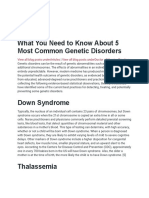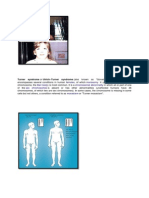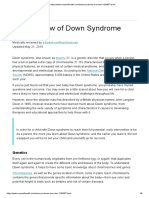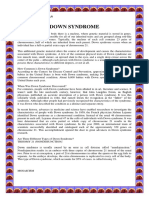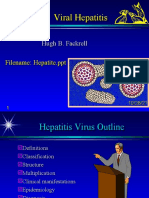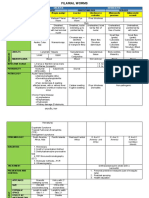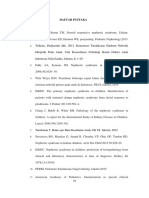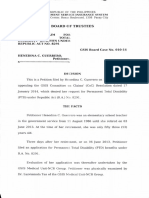0 ratings0% found this document useful (0 votes)
5 viewsGenetic Disorder
Genetic Disorder
Uploaded by
lpagedpedsCopyright:
© All Rights Reserved
Available Formats
Download as DOCX, PDF, TXT or read online from Scribd
Genetic Disorder
Genetic Disorder
Uploaded by
lpagedpeds0 ratings0% found this document useful (0 votes)
5 views3 pagesOriginal Title
Genetic disorder
Copyright
© © All Rights Reserved
Available Formats
DOCX, PDF, TXT or read online from Scribd
Share this document
Did you find this document useful?
Is this content inappropriate?
Copyright:
© All Rights Reserved
Available Formats
Download as DOCX, PDF, TXT or read online from Scribd
Download as docx, pdf, or txt
0 ratings0% found this document useful (0 votes)
5 views3 pagesGenetic Disorder
Genetic Disorder
Uploaded by
lpagedpedsCopyright:
© All Rights Reserved
Available Formats
Download as DOCX, PDF, TXT or read online from Scribd
Download as docx, pdf, or txt
You are on page 1of 3
Kintas, Zyra Yhricka A.
BFS-2A
EXPLAIN AND DISCUSS THE FOLLOWING Genetic Disorders:
1. Down Syndrome (Trisomy 21)
Most Down syndrome sufferers have an extra copy of chromosome 21. Regarding the genetics of
Down syndrome and the correlation between various genotypes and traits, various hypotheses
have been put forth. One of them is a gene dosage imbalance, in which the amount or quantity of
Hsa21 genes is increased, leading to an increase in gene expansion. Following a thorough
examination of several investigations, it became clear that numerous critical areas or essential
genes, rather than a single critical region gene, are more likely to be involved in the phenomena
of trisomy 21.
2. Trisomy 18
A genetic disorder in infants called Edwards syndrome (Trisomy 18) results in severe impairment.
A second copy of chromosome 18 is what causes it, and kids born with it typically do not live
much longer than a week. Instead of the typical 2 copies, children with Edwards syndrome have 3
copies of all or a portion of chromosome 18. This may result from an error during the
development of the egg or sperm, or it could happen while the baby is growing inside the womb.
When a baby has Edwards syndrome, it either miscarries, is stillborn, or is born severely
physically malformed. The majority of babies with Edwards syndrome pass away within a week
of birth, and it is extremely rare for them to survive their first year of life.
3. Trisomy 13
The presence of an extra copy of chromosome 13 in part or all of the body's cells results in
Patau's syndrome, a severe and uncommon genetic condition. Another name for it is trisomy 13.
The genes you inherit from your parents are carried by 23 pairs of chromosomes that are typically
found in each cell. But chromosome 13 is present in three rather than two copies in infants with
Patau's syndrome. This gravely impairs the course of normal development and frequently leads to
miscarriage, stillbirth, or the infant passing away soon after birth.
4. Turner Syndrome
An X chromosome losing all or part of it (monosomy) results in Turner syndrome, an uncommon
chromosomal disease. Turner syndrome is incredibly varied and can vary greatly from person to
person. Female patients may have a wide range of symptoms affecting numerous organ systems.
Short stature and early ovarian failure, which can prevent a person from reaching puberty, are
common symptoms. The majority of Turner syndrome sufferers are infertile. There are numerous
more symptoms that can manifest, such as abnormalities of the eyes, hearing, skeleton, heart, and
kidneys. Although intelligence is often normal, those who are impacted may have certain learning
impairments. Turner syndrome may be identified before birth, soon after delivery, or in the early
years of life.
5. Klinefelter Syndrome
When a boy is born with an extra copy of the X chromosome, a genetic disorder known as
Klinefelter syndrome develops. Klinefelter syndrome is a male-specific genetic disorder that
frequently isn't discovered until adulthood. Klinefelter syndrome may negatively impact testicular
growth, resulting in testicles that are smaller than usual, which can limit testosterone production.
In addition, the disease may result in less body and facial hair, less muscle mass, and increased
breast tissue.
6. Fragile X Syndrome
FXS is a hereditary condition known as fragile X syndrome. A gene termed Fragile X Messenger
Ribonucleoprotein 1 (FMR1) alterations lead to FXS. A protein termed FMRP that is required for
brain development is typically produced by FMR1. FXS patients cannot produce this protein.
Although the FMR1 gene has changed in people with fragile X diseases, they typically still
produce part of the protein. Males and females are both impacted by FXS. However, compared to
men, women frequently exhibit milder symptoms.
7. Triple X syndrome
It is a hereditary condition in which every cell in a female bears an extra copy of the X
chromosome. Triple X syndrome, which only affects women, is a genetic condition but is almost
never inherited. One reason triple X syndrome is believed to be underdiagnosed is that many
females with the ailment don't exhibit any symptoms or indicators of the disorder. Tall stature is
the most typical characteristic, however other women can display a wide range in severity of
symptoms.
8. Cri-du-chat syndrome
When a portion of chromosome number 5 is missing, a series of symptoms known as "cri du chat
syndrome" develop. The name of the syndrome is derived from the baby's high-pitched, feline-
like cry. The majority of occurrences are thought to happen when the egg or sperm are
developing. There are a few instances where a parent transmits their child a different, rearranged
form of the chromosome.
9. Prader-Willi syndrome
A genetic disease called Prader-Willi syndrome (PWS) affects about one in every 15,000
newborns. PWS affects people of all racial and ethnic backgrounds equally, and it equally affects
men and women. The most frequent genetic contributor to the potentially fatal childhood obesity
is known to be PWS. Small hands and feet, abnormal growth and body composition, hypotonia
(weak muscles) at birth, insatiable hunger, extreme obesity, and intellectual disability were among
the common traits listed in the initial report.
10. Duchenne muscular dystrophy
The most prevalent type of muscular dystrophy, a hereditary illness that gradually weakens the
body's muscles, is called Duchenne muscular dystrophy. Toddlers with Duchenne MD may have
big calves and begin walking later than typical. Before age 3 to 5, when muscle weakness makes
it difficult to walk, climb stairs, and engage in other activities, the disease is frequently
undetected.
Reference:
Akhtar, F. (2023, August 8). Down Syndrome. StatPearls - NCBI Bookshelf.
https://www.ncbi.nlm.nih.gov/books/NBK526016/
Cri du chat syndrome. (n.d.). Mount Sinai Health System.
https://www.mountsinai.org/health-library/diseases-conditions/cri-du-chat-syndrome
Duchenne Muscular Dystrophy. (n.d.). Physiopedia. https://www.physio-
pedia.com/Duchenne_Muscular_Dystrophy
Edwards syndrome (Trisomy 18). (n.d.).
https://www.healthdirect.gov.au/edwards-syndrome-trisomy-18
Klinefelter syndrome - Symptoms and causes - Mayo Clinic. (2019, September 21).
Mayo Clinic. https://www.mayoclinic.org/diseases-conditions/klinefelter-syndrome/
symptoms-causes/syc-20353949
Masters, M. (2023, May 30). What Is Triple X Syndrome? Symptoms, Causes,
Diagnosis, Treatment, and Prevention. EverydayHealth.com.
https://www.everydayhealth.com/triple-x-syndrome/guide/
Strong, T.V. (n.d.). What is Prader-Willi Syndrome. https://www.fpwr.org/what-is-
prader-willi-Syndrome-definition
Turner Syndrome - Symptoms, Causes, Treatment | NORD. (2023, July 18).
National Organization for Rare Disorders. https://rarediseases.org/rare-diseases/turner-
syndrome/
What is Fragile X Syndrome (FXS)? | CDC. (2022, June 3). Centers for Disease
Control and Prevention. https://www.cdc.gov/ncbddd/fxs/facts.html#:~:text=Learn
%20more,do%20not%20make%20this%20protein.
Website, N. (2023, July 21). Patau’s syndrome. nhs.uk.
https://www.nhs.uk/conditions/pataus-syndrome/
You might also like
- Test Bank For Anatomy and Physiology For Health Professions 4th Edition by ColbertDocument12 pagesTest Bank For Anatomy and Physiology For Health Professions 4th Edition by ColbertTammy Morrison100% (42)
- Endocrine WorksheetDocument7 pagesEndocrine WorksheetBrenda Zaragoza63% (8)
- Đề Cương Môn Tiếng Anh Chuyên Ngành Ngành: DượcDocument11 pagesĐề Cương Môn Tiếng Anh Chuyên Ngành Ngành: DượcNguyễn Thị Hương75% (8)
- Cardiology NotesDocument15 pagesCardiology NotesShanne Delle Pangpangdeo100% (1)
- Oregano Oil Benefits For Infections, Fungus & More - Dr. Axe PDFDocument7 pagesOregano Oil Benefits For Infections, Fungus & More - Dr. Axe PDFJoseph Tupas100% (1)
- Karyotyping Learning OutcomesDocument3 pagesKaryotyping Learning OutcomesALOIZA BELLE LAVI�ANo ratings yet
- Notes - Genetic DisordersDocument6 pagesNotes - Genetic Disordersanirudhramesh289No ratings yet
- Down SyndromeDocument14 pagesDown SyndromeamitharaoNo ratings yet
- What You Need To Know About 5 Most Common Genetic DisordersDocument9 pagesWhat You Need To Know About 5 Most Common Genetic DisordersJeromeo Hallazgo de LeonNo ratings yet
- Down SyndromeDocument20 pagesDown Syndromebarshanandi82No ratings yet
- AneuploidyDocument4 pagesAneuploidyTingal, Jaynore C.No ratings yet
- TrisomyDocument10 pagesTrisomyDibyakNo ratings yet
- Biology ProjectDocument19 pagesBiology Projecttha7a1987No ratings yet
- DiseasesDocument2 pagesDiseasesMikaela EuniceNo ratings yet
- Approaches To Common Genetic DisordersDocument26 pagesApproaches To Common Genetic DisordersArchita SharmaNo ratings yet
- Turner Syndrome or Ulrich - Turner Syndrome (Also Known As "Gonadal Dysgenesis"), 45, XDocument4 pagesTurner Syndrome or Ulrich - Turner Syndrome (Also Known As "Gonadal Dysgenesis"), 45, XsweetpialiciousNo ratings yet
- Introduction To Chromosomal DisordersDocument4 pagesIntroduction To Chromosomal DisordersKathleenJoyGalAlmasinNo ratings yet
- Name of Syndrome:: Autosomal AneuploidyDocument5 pagesName of Syndrome:: Autosomal AneuploidyMaanNo ratings yet
- Down Syndrome Overview 1120407 PDFDocument6 pagesDown Syndrome Overview 1120407 PDFHartotok VipnetNo ratings yet
- Pre-Reading Genetics DisordersDocument10 pagesPre-Reading Genetics DisordersMya Phone MohNo ratings yet
- Lecture 3Document23 pagesLecture 3Wish fountainNo ratings yet
- SCIENCES GENE REPORT JskaDocument4 pagesSCIENCES GENE REPORT Jskaheart louvNo ratings yet
- Mendelian Disorders Class 12Document22 pagesMendelian Disorders Class 12Harith KumarNo ratings yet
- Genetic Disorders: Recessive Disorders (Homozygous) Description Cases Per Birth Sickle Cell Disease (SCD)Document18 pagesGenetic Disorders: Recessive Disorders (Homozygous) Description Cases Per Birth Sickle Cell Disease (SCD)tango0385100% (1)
- Noninvasive Prenatal Testing For Down Syndrome and Other TrisomiesDocument21 pagesNoninvasive Prenatal Testing For Down Syndrome and Other TrisomiesrpbpaNo ratings yet
- Sindrome de DownDocument27 pagesSindrome de DownKhissi BArzaNo ratings yet
- Down Syndrom (Eng)Document11 pagesDown Syndrom (Eng)Echa MagungNo ratings yet
- Genetic Disorders and CausesDocument3 pagesGenetic Disorders and CausesMorine Andrea P. RuizNo ratings yet
- DNA MutationDocument22 pagesDNA MutationXerxes D. Lozada Jr.No ratings yet
- Down SyndromeDocument3 pagesDown SyndromeMargie Ballesteros Manzano100% (1)
- Chromosomal Disorders SimpleDocument8 pagesChromosomal Disorders SimpleSadia KanwalNo ratings yet
- Chromosomal AbnormalitiesDocument61 pagesChromosomal AbnormalitiesManisanthosh Kumar100% (1)
- Chromosomal DisordersDocument4 pagesChromosomal DisordersMatth N. ErejerNo ratings yet
- 7 Down SyndromeDocument5 pages7 Down SyndromeAdnan RezaNo ratings yet
- Down Syndrome and Other Abnormalities of Chromosome NumberDocument29 pagesDown Syndrome and Other Abnormalities of Chromosome Numbersamritt022No ratings yet
- Ày Ày Ày Ày Ày Ày ÀyDocument9 pagesÀy Ày Ày Ày Ày Ày Àyfelicen24No ratings yet
- NCMDocument56 pagesNCMPatrick Perreras Dela CuadraNo ratings yet
- Presidency School Mangalore: Chromosomal DisordersDocument28 pagesPresidency School Mangalore: Chromosomal DisordersAiman SyedNo ratings yet
- Kelainan GenetikDocument36 pagesKelainan GenetikImas Siti MNo ratings yet
- Kinfelter SyndromeDocument2 pagesKinfelter SyndromeAica PamintuanNo ratings yet
- Kelainan GenetikDocument36 pagesKelainan GenetikNicko Erdy Kusuma100% (1)
- Clinical Vignette 1Document9 pagesClinical Vignette 1Joanne Alyssa Hernandez LascanoNo ratings yet
- Chromosome 18 - 094757Document4 pagesChromosome 18 - 094757Shann Angel MarciaNo ratings yet
- Class 12 Biology Investigatory ProjectDocument18 pagesClass 12 Biology Investigatory ProjectJ. Suba SriNo ratings yet
- Edward Syndrome OriginalDocument10 pagesEdward Syndrome OriginalArun PrabuNo ratings yet
- West SyndromeDocument6 pagesWest SyndromeRohit Vishal KumarNo ratings yet
- Edwards Down SyndromeDocument5 pagesEdwards Down Syndromeapi-346355246No ratings yet
- Handnotes OCP 103Document177 pagesHandnotes OCP 103Syahmi AgüeroNo ratings yet
- Genetic Disorders DiseasesDocument17 pagesGenetic Disorders Diseasesynnej5891No ratings yet
- Genetic Diseases in The Philippines: Genetic Diseases Are Related To Genetic Mutations and InheritanceDocument4 pagesGenetic Diseases in The Philippines: Genetic Diseases Are Related To Genetic Mutations and InheritanceGracy JavierNo ratings yet
- Klinefelter SyndromeDocument12 pagesKlinefelter SyndromeJustine Mae BatadlanNo ratings yet
- Etiology PPPDocument24 pagesEtiology PPPCresty Estalilla100% (1)
- Numerical - 1: Structural - 2Document9 pagesNumerical - 1: Structural - 2Khaled Zeama100% (1)
- Biology Investigatory ProjectDocument10 pagesBiology Investigatory Projectmohd faizzNo ratings yet
- KaryotypeDocument26 pagesKaryotypeBraxton PhillipsNo ratings yet
- Epidemiology: Down Syndrome, or Down's Syndrome (Primarily in The United Kingdom)Document9 pagesEpidemiology: Down Syndrome, or Down's Syndrome (Primarily in The United Kingdom)anupa_joyNo ratings yet
- Birth Defects and Prenatal DiagnosisDocument20 pagesBirth Defects and Prenatal DiagnosisGaurav PatodiaNo ratings yet
- Cri Du Chat Syndrome - Symptoms, Causes, Treatment - NORDDocument9 pagesCri Du Chat Syndrome - Symptoms, Causes, Treatment - NORDis_julieNo ratings yet
- Genetics DisorderDocument42 pagesGenetics DisorderRoshan jaiswalNo ratings yet
- Chromosomal Abnormalities (I I) 6 SDK 2013Document63 pagesChromosomal Abnormalities (I I) 6 SDK 2013Edward WinchesterrNo ratings yet
- What Is Down Syndrome?: English Village, Gulan Street, Erbil, Kurdistan Region of IraqDocument10 pagesWhat Is Down Syndrome?: English Village, Gulan Street, Erbil, Kurdistan Region of IraqclubsanatateNo ratings yet
- Sex Ed Uncensored - Sexual Identity: Mind Blowing Sex Sh8t!!! for Young AdultsFrom EverandSex Ed Uncensored - Sexual Identity: Mind Blowing Sex Sh8t!!! for Young AdultsNo ratings yet
- ADHDDocument29 pagesADHDiiout346No ratings yet
- Trauma Infographic Print VersionDocument2 pagesTrauma Infographic Print VersionSparking The Genius100% (1)
- Self Instructional Training Methods To R 08c89fef PDFDocument6 pagesSelf Instructional Training Methods To R 08c89fef PDFIbu SaniyahNo ratings yet
- BOMSS Standards For Clinical ServicesDocument4 pagesBOMSS Standards For Clinical ServiceskintNo ratings yet
- Osteomyelitis and Septic ArthritisDocument30 pagesOsteomyelitis and Septic Arthritismaregesi80No ratings yet
- Kayexalate Drug StudyDocument3 pagesKayexalate Drug StudyAngelou Joefred Congreso100% (1)
- Carcinoma Oesophagus: Dr. S. Ranita DeviDocument46 pagesCarcinoma Oesophagus: Dr. S. Ranita DeviVivek AhanthemNo ratings yet
- Etiology - The Etiology of Psoriasis Is ADocument2 pagesEtiology - The Etiology of Psoriasis Is AJake DukesNo ratings yet
- Hepatites 1Document49 pagesHepatites 1Milan JavornikNo ratings yet
- 10besar Kode PenyakitDocument5 pages10besar Kode PenyakitDEWINo ratings yet
- Health Products ITGIDocument1 pageHealth Products ITGISoumitra PaulNo ratings yet
- Protandim Summary of Clinical Studies - NutrigenomicsDocument3 pagesProtandim Summary of Clinical Studies - NutrigenomicsProtandimFanNo ratings yet
- Manual Test Estrés PostraumáticoDocument8 pagesManual Test Estrés PostraumáticoDan CampozNo ratings yet
- Lazar 2023 Systemic Lupus Erythematosus New DiDocument17 pagesLazar 2023 Systemic Lupus Erythematosus New DiunidadmedicamazamitlaNo ratings yet
- TABLE (Filarial Worms)Document3 pagesTABLE (Filarial Worms)TRISHA MAE ORDONANo ratings yet
- Careram: Tablets 25 MGDocument6 pagesCareram: Tablets 25 MGPriya Ranjan100% (1)
- Neuropsychiatric Manifestations of HIVDocument46 pagesNeuropsychiatric Manifestations of HIVDivya MNo ratings yet
- Bitter PrinciplesDocument6 pagesBitter PrinciplesPankaj BudhlakotiNo ratings yet
- Sindroma Nefrotik DAFTAR PUSTAKADocument3 pagesSindroma Nefrotik DAFTAR PUSTAKAEvi Dian PuspitaliseNo ratings yet
- Fitness Progress Chart For Women (Metric)Document4 pagesFitness Progress Chart For Women (Metric)Marius MitricăNo ratings yet
- Drug StudyDocument12 pagesDrug Studyjoaqiun100% (1)
- Chapter 18. A Safe Diagnostic StrategyDocument16 pagesChapter 18. A Safe Diagnostic StrategyMar HesNo ratings yet
- Guide For Eating After Gastric Bypass SurgeryDocument42 pagesGuide For Eating After Gastric Bypass Surgerymolly brown100% (3)
- MalnutritionDocument15 pagesMalnutritionSarthak GuptaNo ratings yet
- Gsis Case 20141112-Case-010-14Document11 pagesGsis Case 20141112-Case-010-14Maria Fiona Duran MerquitaNo ratings yet








